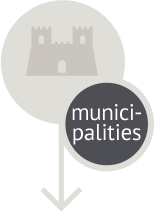Between the end of the 16th and beginning of the 17th century, the Municipal Building was endowed with a facade and loggia in which the coat-of-arms of the newly elected popes were painted. From mid-18th century radical restructuring was contemplated.
During the French occupation a new facade was made and the outside square was extended. So, for three thousand five hundred lira, Appignano obtained a decorous Public Building, a larger square and also a cemetery. The construction was almost completely finished in 1812.
The structure is based on a square plan with meticulous compositional balance and calculated symmetry. The loggia presents three arches. The double-gabled pediment alludes to a neoclassical architectural culture. But in the 1950’s, another floor was added above, eliminating the gable and annexed clock, thus compromising the balance of the 18th century facade. Grave structural problems resulted and consequently the building was abandoned. Recently, restoration work has reinstated the building to its public function. 16th – 19th centuries





